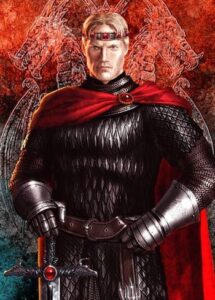Before the arrival of the Targaryens, Westeros was a continent divided into seven independent kingdoms, each ruled by its own monarch. These kingdoms were:
- The Kingdom of the North: Ruled by House Stark from Winterfell.
- The Kingdom of the Mountain and the Vale: Ruled by House Arryn from the Eyrie.
- The Kingdom of the Isles and Rivers: Ruled by House Hoare from Harrenhal.
- The Kingdom of the Rock: Ruled by House Lannister from Casterly Rock.
- The Kingdom of the Stormlands: Ruled by House Durrandon from Storm’s End.
- The Kingdom of the Reach: Ruled by House Gardener from Highgarden.
- The Principality of Dorne: Ruled by House Martell from Sunspear.
These kingdoms often engaged in conflicts and wars with each other, resulting in a fractured and tumultuous political landscape. Alliances were fragile, and power struggles were frequent.
The Arrival of the Targaryens
The Targaryens were originally from Valyria, a powerful and advanced civilization known for its dragons and sorcery. The Targaryens were a noble family in Valyria but not one of its most powerful houses. About a century before the Doom of Valyria, the Targaryens relocated to the island of Dragonstone, just off the coast of Westeros. This move was prompted by Daenys the Dreamer, who foresaw the destruction of Valyria in a prophetic dream.
In 102 BC (Before Conquest), the Doom of Valyria occurred, annihilating the Valyrian Freehold and most of its dragonlords. The Targaryens survived on Dragonstone, and over the next century, they consolidated their power and resources.
The Conquest of Westeros
Aegon I Targaryen, known as Aegon the Conqueror, along with his sister-wives, Visenya and Rhaenys, embarked on the conquest of Westeros in 2 BC. Aegon’s ambition was to unite the seven independent kingdoms into one realm under his rule. Here’s how he accomplished this:
- Initial Landing and Strategy:
- Aegon landed at the mouth of the Blackwater Rush, where he established the Aegonfort, which would later become King’s Landing.
- He divided his forces strategically, sending Rhaenys to the Stormlands, Visenya to the Vale, and leading the main force himself.
- Key Battles and Submissions:
- Field of Fire: Aegon defeated the combined armies of the Reach and the Westerlands. His dragons, Balerion, Vhagar, and Meraxes, decimated the enemy forces with dragonfire.
- Burning of Harrenhal: Aegon used Balerion the Black Dread to destroy Harrenhal, forcing Harren the Black to surrender.
- Submission of the North: Torrhen Stark, the King in the North, chose to bend the knee to Aegon rather than face the might of his dragons, earning the moniker “The King Who Knelt.”
- Surrender of the Vale: Visenya flew to the Eyrie on her dragon, Vhagar, and convinced the young King Ronnel Arryn’s mother to surrender without a fight.
- Conquest of the Stormlands: Rhaenys and her dragon, Meraxes, subdued Argilac the Arrogant, the last Storm King, and secured the Stormlands.
- Consolidation of Power:
- After securing the submission of most of the kingdoms, Aegon turned his attention to Dorne. However, Dorne resisted Targaryen rule for many years, using guerrilla tactics and their knowledge of the terrain to avoid direct confrontation.
Unification of the Seven Kingdoms
By 1 AC, Aegon I Targaryen had been crowned the first king of the unified realm of Westeros, sitting on the Iron Throne. The Iron Throne itself was forged from the swords of his defeated enemies, symbolizing his dominion over the Seven Kingdoms. His reign marked the beginning of the Targaryen dynasty and a new era for Westeros, bringing an unprecedented level of unity and centralized power to the continent.
This unification under Aegon I Targaryen set the stage for the subsequent history of Westeros, where the Targaryens would rule for nearly three centuries, shaping the political and cultural landscape of the realm.
All Kings of Westeros
1. Aegon I Targaryen (Aegon the Conqueror)

How He Became King: Aegon I Targaryen, also known as Aegon the Conqueror, began his conquest of Westeros in 2 BC (Before Conquest). Along with his sister-wives, Visenya and Rhaenys, and their dragons—Balerion, Vhagar, and Meraxes—Aegon set out to unite the Seven Kingdoms under his rule. The conquest was a strategic and military campaign that spanned two years.
Reign: Aegon I’s reign lasted from 1 AC (After Conquest) to 37 AC. He established the Targaryen dynasty and laid the foundation for the unified realm of Westeros.
How He Ruled: Aegon I ruled as a strong and pragmatic king. He was known for his fairness and willingness to adopt existing customs and traditions. He maintained the loyalty of his subjects through a combination of strength, diplomacy, and justice.
Success or Failure: Aegon’s rule was largely considered a success. He successfully unified the Seven Kingdoms, a feat that had never been accomplished before. His reign brought a degree of peace and stability to Westeros, setting the stage for future Targaryen rulers.
Changes in Westeros:
- Political Structure: Aegon established the Iron Throne as the seat of power in Westeros and made King’s Landing the capital.
- Feudal System: He maintained the feudal structure but required all the lords to swear fealty directly to him.
- Legal Reforms: Aegon introduced the concept of royal justice, intervening in local disputes when necessary to ensure fairness.
Peacefulness of Reign: Aegon’s reign saw significant military campaigns initially, but once the conquest was complete, his rule was relatively peaceful. He was able to maintain control and quell rebellions through his personal strength and the might of his dragons.
Battles Fought:
- Field of Fire: Aegon defeated the combined armies of the Reach and the Westerlands, solidifying his claim to those regions.
- Submission of the North: Torrhen Stark, the King in the North, bent the knee to Aegon, thereby avoiding conflict.
- Siege of Harrenhal: Aegon used Balerion to destroy Harrenhal, forcing the surrender of Harren the Black.
End of Reign: Aegon I Targaryen died of natural causes in 37 AC. His death marked the end of a significant and transformative reign. He was succeeded by his son, Aenys I Targaryen.
2. Aenys I Targaryen
How He Became King: Aenys I Targaryen was the second king of the Targaryen dynasty, ascending the throne after the death of his father, Aegon the Conqueror, in 37 AC. He was the eldest son of Aegon I and his sister-wife, Rhaenys Targaryen.
Reign: Aenys I’s reign lasted from 37 AC to 42 AC, a total of five years.
How He Ruled: Aenys I was known for being a gentle and indecisive ruler, which made his reign challenging. He lacked the firm hand and military prowess of his father, leading to difficulties in maintaining control over the realm.
Success or Failure: Aenys I’s reign is generally considered a failure due to his inability to effectively manage the kingdom and suppress rebellions. His indecisiveness and leniency were seen as weaknesses, which emboldened his enemies and led to unrest.
Changes in Westeros:
- Construction Projects: Aenys I continued some of his father’s construction projects, including the expansion of King’s Landing and the building of the Dragonpit, a large domed structure meant to house the royal dragons.
- Religious Tensions: His reign saw the rise of religious tensions as the Faith Militant, the military arm of the Faith of the Seven, rebelled against Targaryen rule, viewing the Targaryens as abominations due to their incestuous practices and use of dragons.
Peacefulness of Reign: Aenys I’s reign was marked by significant unrest and rebellion. The Faith Militant uprising was a major challenge, as were various rebellions by lords dissatisfied with Targaryen rule.
Battles Fought:
- Faith Militant Uprising: The Faith Militant, consisting of the Warrior’s Sons and the Poor Fellows, rose against Aenys I, leading to widespread conflict. Aenys struggled to suppress this rebellion effectively.
End of Reign: Aenys I Targaryen’s reign ended abruptly when he died of illness in 42 AC, at the age of 35. His death was sudden and may have been hastened by the stress and pressures of his troubled rule. Following his death, his half-brother Maegor I Targaryen (Maegor the Cruel) seized the throne, leading to a period of brutal suppression and consolidation of power.
3. Maegor I Targaryen (Maegor the Cruel)
How He Became King: Maegor I Targaryen, known as Maegor the Cruel, became king after the death of his half-brother, Aenys I Targaryen. Despite being Aenys’s younger half-brother, Maegor seized the throne in 42 AC with the support of his mother, Visenya Targaryen, and his dragon, Balerion the Black Dread. His ascension was marked by controversy and conflict, as he usurped the throne from Aenys’s son, Prince Aegon.
Reign: Maegor’s reign lasted from 42 AC to 48 AC, a total of six years.
How He Ruled: Maegor ruled with an iron fist and a ruthless disposition. He was known for his brutality and willingness to use extreme measures to maintain control. His rule was characterized by a series of violent and oppressive actions designed to crush dissent and rebellion.
Success or Failure: Maegor’s reign is often viewed as a failure due to his inability to win the loyalty of his subjects and the widespread unrest his actions caused. While he succeeded in temporarily quelling rebellion, his brutal methods led to deep resentment and fear among the nobility and commoners alike.
Changes in Westeros:
- Suppression of the Faith Militant: Maegor aggressively targeted the Faith Militant, using Balerion and his armies to ruthlessly suppress the Warrior’s Sons and Poor Fellows. He destroyed the Sept of Remembrance on Rhaenys’s Hill in King’s Landing, killing many of the Warrior’s Sons inside.
- Construction Projects: Maegor continued the construction of the Red Keep in King’s Landing, including the completion of its formidable dungeons and hidden passageways, ensuring it would be a fortress capable of withstanding any siege.
- Marriage Policies: Maegor married multiple times in an attempt to secure a male heir, but all his marriages were marked by tragedy, with many of his wives dying under suspicious circumstances or failing to produce surviving offspring.
Peacefulness of Reign: Maegor’s reign was far from peaceful. It was marked by constant rebellions, uprisings, and a pervasive atmosphere of fear. His draconian measures to maintain control only served to fuel further unrest.
Battles Fought:
- Battle of the Great Fork: Maegor fought and defeated Prince Aegon, the son of Aenys I, who had claimed the throne. Aegon was killed in battle, and Maegor solidified his claim.
- Various Rebellions: Throughout his reign, Maegor faced numerous uprisings from dissatisfied lords and followers of the Faith Militant, which he suppressed with extreme force.
End of Reign: Maegor’s reign ended mysteriously in 48 AC. He was found dead on the Iron Throne, impaled on its blades. The circumstances of his death remain unclear, with theories ranging from suicide to assassination. His death was met with widespread relief and marked the end of a particularly dark and brutal period in Targaryen rule.
4. Jaehaerys I Targaryen (The Conciliator)

How He Became King: Jaehaerys I Targaryen ascended to the throne in 48 AC, following the tumultuous reign and mysterious death of his uncle, Maegor the Cruel. Jaehaerys was the son of Aenys I Targaryen and Alyssa Velaryon. His claim was supported by many lords and the populace, who were eager for a peaceful and just ruler after Maegor’s tyranny. At the time of his ascension, Jaehaerys was just 14 years old, but he quickly demonstrated wisdom and a conciliatory nature.
Reign: Jaehaerys I reigned from 48 AC to 103 AC, making his rule the longest in Targaryen history, spanning 55 years.
How He Ruled: Jaehaerys was known for his wisdom, fairness, and dedication to peace and prosperity. His reign is often referred to as the Golden Age of Westeros. He was aided by his wife and queen, Alysanne Targaryen, who played a crucial role in his rule. Together, they focused on reconciliation, legal reform, and infrastructural development.
Success or Failure: Jaehaerys I’s reign was a resounding success. He managed to heal the wounds left by his predecessors, established lasting peace, and implemented significant reforms that improved the lives of his subjects.
Changes in Westeros:
- Legal Reforms: Jaehaerys initiated numerous legal reforms, codifying the laws of the realm into a more coherent system. He created the position of the “Master of Laws” to oversee legal matters.
- Infrastructure: His reign saw the construction of roads, bridges, and other infrastructure projects that enhanced trade and communication across the Seven Kingdoms. The Kingsroad, which connected the North to the capital, was one of his most notable projects.
- Council of 101 AC: Jaehaerys convened the Great Council of 101 AC to settle the matter of succession, ensuring a smooth transition of power after his death.
- The Targaryen Dynasty: His policies and diplomatic marriages helped solidify the Targaryen dynasty’s hold on the throne, fostering loyalty among the noble houses.
Peacefulness of Reign: Jaehaerys I’s reign was remarkably peaceful. He managed to maintain harmony through wise governance, effective diplomacy, and a focus on justice and the well-being of his people. His ability to resolve conflicts and build consensus earned him the title “The Conciliator.”
Battles Fought: Jaehaerys I’s reign was notable for its lack of major battles or rebellions. His diplomatic skills and fair rule precluded the need for significant military engagements.
End of Reign: Jaehaerys I Targaryen died peacefully in 103 AC at the age of 69. His death marked the end of a golden era of peace and prosperity for Westeros. He was succeeded by his grandson, Viserys I Targaryen, chosen through the Great Council of 101 AC.
5. Viserys I Targaryen

How He Became King: Viserys I Targaryen ascended to the throne in 103 AC following the death of his grandfather, Jaehaerys I Targaryen. His claim was solidified by the Great Council of 101 AC, which established the principle of male-preference primogeniture in the Targaryen succession.
Reign: Viserys I reigned from 103 AC to 129 AC, a total of 26 years.
How He Ruled: Viserys I was a conscientious and capable ruler, but his reign was marked by growing political intrigue and challenges. He sought to emulate his grandfather’s legacy of peace and prosperity but faced increasing tensions and rivalries among the noble houses.
Success or Failure: Viserys I’s early reign was successful in maintaining stability and continuing the prosperity initiated by Jaehaerys I. However, his later years saw the seeds of conflict that would eventually lead to civil war.
Changes in Westeros:
- Expansion of King’s Landing: Viserys I oversaw further expansion and development of King’s Landing, including the construction of the Dragonpit and improvements to the city’s infrastructure.
- Dynastic Challenges: His reign was marked by dynastic challenges and succession disputes, particularly surrounding the legitimacy of his children and grandchildren.
Peacefulness of Reign: Viserys I’s early reign was relatively peaceful, maintaining the stability and prosperity of Jaehaerys I’s era. However, tensions and rivalries began to surface later in his reign, leading to growing discontent and division among the noble houses.
Battles Fought:
- Dance of the Dragons: The most significant conflict of Viserys I’s reign was the Dance of the Dragons civil war, fought between his daughter Rhaenyra Targaryen and his nephew Aegon II Targaryen over the Iron Throne. The war devastated Westeros and resulted in significant loss of life and destruction.
End of Reign: Viserys I Targaryen died in 129 AC under suspicious circumstances. His death marked the beginning of the Dance of the Dragons civil war, which would plunge the realm into chaos and ultimately reshape the Targaryen dynasty.
6. Aegon II Targaryen

How He Became King: Aegon II Targaryen became king during the tumultuous period known as the Dance of the Dragons, a civil war fought between him and his half-sister Rhaenyra Targaryen over their claim to the Iron Throne. Aegon II was supported by his mother, Queen Alicent Hightower, and the greens faction, which included many powerful lords who opposed Rhaenyra’s claim.
Reign: Aegon II’s reign lasted from 129 AC to 131 AC, a period of just two years marked by violence and instability.
How He Ruled: Aegon II’s rule was characterized by brutality and the desperation to maintain power. He was viewed as a usurper by supporters of Rhaenyra, and his reign was marked by violence, betrayal, and political intrigue.
Success or Failure: Aegon II’s reign is considered a failure due to the chaos and devastation caused by the Dance of the Dragons civil war. His claim to the throne was disputed, and his rule was marked by widespread opposition and rebellion.
Changes in Westeros:
- Civil War: Aegon II’s reign was dominated by the Dance of the Dragons, a devastating civil war between his faction (the greens) and Rhaenyra’s faction (the blacks). The war led to widespread destruction, loss of life, and division across the Seven Kingdoms.
Peacefulness of Reign: Aegon II’s reign was anything but peaceful. It was marked by intense conflict and bloodshed as he fought to secure his claim against Rhaenyra and her supporters.
Battles Fought:
- Storming of King’s Landing: Aegon II’s forces, with the support of his mother Alicent and the greens, seized King’s Landing from Rhaenyra’s supporters in a brutal attack that left the city in ruins.
- Dragon Battles: The war included numerous battles involving dragons, leading to the deaths of many dragons and dragonriders on both sides.
End of Reign: Aegon II Targaryen died in 131 AC from injuries sustained during the war. His death marked the end of the Dance of the Dragons and the beginning of the regency of Aegon III Targaryen, who inherited a fractured and war-torn realm.
7. Rhaenyra Targaryen (disputed, during the Dance of the Dragons)

Claim to the Throne: Rhaenyra Targaryen was the daughter of King Viserys I Targaryen and his first wife, Queen Aemma Arryn. She was Viserys’s eldest surviving child and was initially designated as his heir. However, her claim to the throne was disputed due to the traditional preference for male heirs in Westerosi succession.
During the Dance of the Dragons: The Dance of the Dragons was a civil war fought between Rhaenyra and her half-brother Aegon II Targaryen over their claim to the Iron Throne. Rhaenyra, supported by her faction known as the blacks, asserted her right as Viserys I’s designated heir against Aegon II, who was viewed as a usurper by her supporters.
Reign: Rhaenyra’s reign as queen was tumultuous and short-lived. She was crowned queen in King’s Landing during the early stages of the civil war, but her hold on power was contested by Aegon II and his supporters.
How She Ruled: Rhaenyra ruled with determination and ambition, seeking to uphold her claim and assert her authority as the rightful ruler of Westeros. She faced significant challenges, including betrayal from within her own family and the military strength of Aegon II’s forces.
Success or Failure: Rhaenyra’s reign is considered a failure due to the ultimate defeat of her faction in the Dance of the Dragons. Despite initially securing the Iron Throne, she faced intense opposition and was eventually overthrown by Aegon II’s forces.
Changes in Westeros:
- Dragon Battles: Rhaenyra’s reign saw fierce battles fought between dragons and dragonriders on both sides, leading to the deaths of many dragons and significant destruction across the realm.
- Impact on Succession: The Dance of the Dragons had a profound impact on Westerosi succession, as it highlighted the complexities and disputes surrounding the line of succession within the Targaryen dynasty.
Peacefulness of Reign: Rhaenyra’s reign was marked by intense conflict and bloodshed as she fought to maintain her claim to the throne against the forces aligned with Aegon II.
End of Reign: Rhaenyra’s reign came to a tragic end when she was betrayed and captured by her half-brother Aegon II’s supporters. She was fed to his dragon, Sunfyre, in a brutal and symbolic act of vengeance. Her death marked the end of the blacks’ resistance in the Dance of the Dragons.
8. Aegon III Targaryen (Dragonbane)
How He Became King: Aegon III Targaryen, also known as Aegon the Dragonbane, ascended to the throne in 131 AC following the death of his uncle, Aegon II Targaryen, during the Dance of the Dragons civil war. Aegon III was the son of Rhaenyra Targaryen and was chosen as king by the remnants of his mother’s faction, the blacks, and their supporters.
Reign: Aegon III’s reign lasted from 131 AC to 157 AC, a period of 26 years.
How He Ruled: Aegon III’s reign was marked by melancholy and introspection, shaped by the traumatic events of the Dance of the Dragons and the loss of his mother, Rhaenyra, during the conflict. He was known for his withdrawn and somber demeanor, reflecting the deep scars left by the war.
Success or Failure: Aegon III’s reign is generally viewed as a mixed success. While he succeeded in restoring stability to the realm after the devastation of the Dance of the Dragons, his melancholic nature and struggles with governance left a somewhat subdued mark on Targaryen rule.
Changes in Westeros:
- End of Dragons: Aegon III’s reign marked the decline and eventual extinction of dragons in Westeros. The last dragon, known as Silverwing, died during his reign, marking the end of an era of dragonlords and their fearsome creatures.
- Reconstruction: Aegon III oversaw efforts to rebuild and reconstruct Westeros in the aftermath of the civil war. His reign focused on healing the wounds of the realm and restoring stability.
Peacefulness of Reign: Aegon III’s reign was relatively peaceful compared to the chaos of the Dance of the Dragons. He sought to avoid further conflict and focused on rebuilding efforts and reconciliation.
End of the Reign: Aegon III Targaryen died in 157 AC at the age of 36, reportedly of a broken heart. His death marked the end of the direct line of House Targaryen descended from Aegon the Conqueror’s children, as his only surviving child, Daeron I Targaryen, inherited the throne.
9. Daeron I Targaryen (The Young Dragon)
How He Became King: Daeron I Targaryen, known as The Young Dragon, ascended to the throne in 157 AC following the death of his father, Aegon III Targaryen. Daeron was the eldest son of Aegon III and succeeded him as king at the age of 14.
Reign: Daeron I’s reign lasted from 157 AC to 161 AC, a brief but impactful period of four years.
How He Ruled: Daeron I ruled with ambition and vigor, eager to expand Targaryen influence and assert control over the remaining independent kingdoms of Westeros. He sought to emulate the conquests of his ancestors, particularly Aegon the Conqueror, by expanding the boundaries of the Seven Kingdoms.
Success or Failure: Daeron I’s reign is considered a partial success due to his successful military campaigns and conquests, particularly his conquest of Dorne. However, his reign was cut short, and his ambitious plans for further expansion were not fully realized.
Changes in Westeros:
- Conquest of Dorne: Daeron I’s most notable achievement was the conquest of Dorne, a region that had resisted Targaryen rule for centuries. Through a combination of military strategy, alliances, and diplomacy, Daeron successfully brought Dorne into the realm of the Seven Kingdoms. However, the conquest proved difficult to maintain in the long term due to Dorne’s resistance and guerrilla warfare tactics.
Peacefulness of Reign: Despite his successful conquests, Daeron I’s reign was marked by ongoing conflict and resistance, particularly in Dorne. The region remained a source of instability and rebellion throughout his brief reign.
Battles Fought:
- Conquest of Dorne: Daeron I led a military campaign into Dorne, facing fierce resistance from the Dornish forces. The conquest involved several battles and sieges, culminating in the submission of Dorne to Targaryen rule.
End of Reign: Daeron I Targaryen died in 161 AC under mysterious circumstances, reportedly assassinated while trying to maintain control over Dorne. His death marked the end of his ambitious plans for further expansion and left a legacy of both conquest and unfinished aspirations.
10. Baelor I Targaryen (Baelor the Blessed)
How He Became King: Baelor I Targaryen, known as Baelor the Blessed, ascended to the throne in 161 AC following the death of his brother, Daeron I Targaryen. Baelor was chosen as king despite being a septon and having no desire for the throne. He was selected due to his piety and perceived purity.
Reign: Baelor I’s reign lasted from 161 AC to 171 AC, a period of ten years marked by religious fervor and asceticism.
How He Ruled: Baelor I ruled as a deeply devout and ascetic king, guided by his intense religious convictions and commitment to the Faith of the Seven. His reign was characterized by piety, charity, and a focus on religious purity.
Success or Failure: Baelor I’s reign is considered a mixed success. While he was revered for his piety and moral rectitude, his extreme religious fervor led to policies and decisions that were seen as impractical and detrimental to the realm’s governance.
Changes in Westeros:
- Religious Influence: Baelor I elevated the influence of the Faith of the Seven during his reign, strengthening ties between the crown and the Faith and promoting religious purity and asceticism among the nobility.
- Construction of the Great Sept: Baelor I commissioned the construction of the Great Sept of Baelor in King’s Landing, a magnificent sept dedicated to the Faith of the Seven, which remains a prominent religious site in Westeros.
Peacefulness of Reign: Baelor I’s reign was relatively peaceful compared to the military campaigns of his predecessor, Daeron I. His focus on religious devotion and pacifism contributed to a period of internal stability, although challenges persisted.
End of Reign: Baelor I Targaryen died in 171 AC, reportedly from self-inflicted starvation while in prayer. His extreme ascetic practices and devotion to the Faith of the Seven ultimately led to his premature death. He was succeeded by his uncle, Viserys II Targaryen.
11. Viserys II Targaryen
How He Became King: Viserys II Targaryen ascended to the throne in 171 AC following the death of his nephew, Baelor I Targaryen. Viserys II was the younger brother of Baelor I and was chosen as king due to his experience and reputation for intelligence and political acumen.
Reign: Viserys II’s reign was short, lasting only from 171 AC to 172 AC, a period of just one year.
How He Ruled: Viserys II ruled as a pragmatic and capable king, known for his skill in diplomacy and governance. He sought to stabilize the realm and undo some of the policies and decisions of his predecessor, Baelor I.
Success or Failure: Viserys II’s reign is considered a brief success in terms of stabilizing the realm and preparing for future challenges. However, his sudden death cut short his efforts to fully implement his policies.
Changes in Westeros:
- Reversal of Policies: Viserys II sought to undo some of the more extreme religious policies of Baelor I, promoting a more pragmatic approach to governance and diplomacy.
- Political Reforms: During his short reign, Viserys II initiated political reforms aimed at strengthening royal authority and centralizing power within the crown.
Peacefulness of Reign: Viserys II’s reign was relatively peaceful, focusing on internal governance and stability rather than external conflicts. His diplomatic skills helped mitigate potential sources of unrest.
End of Reign: Viserys II Targaryen died suddenly in 172 AC, reportedly from a sudden illness. His death led to a succession crisis and set the stage for political intrigue and rival claims to the throne.
12. Aegon IV Targaryen (The Unworthy)
How He Became King: Aegon IV Targaryen, known as Aegon the Unworthy, ascended to the throne in 172 AC following the death of his father, Viserys II Targaryen. Aegon IV’s claim to the throne was uncontested, but his reign would become infamous for its excesses and misrule.
Reign: Aegon IV’s reign lasted from 172 AC to 184 AC, a period of 12 years marked by corruption, debauchery, and political intrigue.
How He Ruled: Aegon IV ruled with self-indulgence and irresponsibility, squandering the realm’s resources on lavish feasts, tournaments, and personal pleasures. His reign was characterized by favoritism, corruption, and the promotion of his own desires over the welfare of the realm.
Success or Failure: Aegon IV’s reign is widely regarded as a failure due to the detrimental impact of his personal excesses and irresponsible governance on the realm. His actions sowed seeds of discontent and division among the noble houses, leading to future conflicts and instability.
Changes in Westeros:
- Blackfyre Rebellion: Aegon IV’s actions indirectly contributed to the Blackfyre Rebellion, as his legitimization of his bastards, including Daemon Blackfyre, led to rival claims to the throne and sparked a civil war that divided the realm.
- Deterioration of Royal Authority: Under Aegon IV, royal authority deteriorated as corruption and favoritism undermined the legitimacy and effectiveness of the crown.
Peacefulness of Reign: Aegon IV’s reign was marked by internal strife and growing discontent among the noble houses, exacerbated by his favoritism and manipulation of court politics.
Battles Fought:
- Blackfyre Rebellion: The Blackfyre Rebellion, sparked by Aegon IV’s legitimization of his bastards, including Daemon Blackfyre, led to a series of conflicts between supporters of House Blackfyre and House Targaryen. These conflicts culminated in several battles and skirmishes across Westeros.
End of Reign: Aegon IV Targaryen died in 184 AC, reportedly from a combination of his excesses and poor health. His death marked the end of a troubled reign and set the stage for the tumultuous events of the Blackfyre Rebellions and the subsequent struggles for the Iron Throne.
13. Daeron II Targaryen
How He Became King: Daeron II Targaryen ascended to the throne in 184 AC following the death of his father, Aegon IV Targaryen. Daeron II’s claim to the throne was initially contested due to the legitimacy issues surrounding his father’s reign and the Blackfyre Rebellion. However, Daeron II was ultimately recognized as king and worked to solidify his rule.
Reign: Daeron II’s reign lasted from 184 AC to 209 AC, a period of 25 years marked by political stability, diplomacy, and consolidation of royal authority.
How He Ruled: Daeron II ruled with a focus on diplomacy, reform, and consolidation of power. He sought to heal the divisions caused by his father’s reign and the Blackfyre Rebellion, promoting unity and stability within the Seven Kingdoms.
Success or Failure: Daeron II’s reign is considered a success due to his efforts in strengthening royal authority, fostering peace, and implementing political reforms. He managed to navigate the complexities of Westerosi politics and maintain relative stability throughout his reign.
Changes in Westeros:
- Dornish Integration: Daeron II’s most notable achievement was the peaceful integration of Dorne into the Seven Kingdoms through marriage alliances rather than conquest. This ended centuries of conflict and brought Dorne fully into the realm.
- Political Reforms: Daeron II implemented reforms aimed at centralizing royal authority and improving governance across the Seven Kingdoms. His policies contributed to a more unified and stable realm.
Peacefulness of Reign: Daeron II’s reign was relatively peaceful compared to the tumultuous periods preceding it. His diplomatic skills and political reforms helped mitigate internal conflicts and maintain stability.
Battles Fought:
- First Blackfyre Rebellion: Early in his reign, Daeron II faced the First Blackfyre Rebellion, led by Daemon Blackfyre, a legitimatized bastard of Aegon IV. The rebellion was ultimately defeated, but it highlighted ongoing challenges to Targaryen rule.
End of Reign: Daeron II Targaryen died in 209 AC, reportedly from illness. His death marked the end of a successful reign that saw significant achievements in diplomacy, governance, and the consolidation of Targaryen rule.
14. Aerys I Targaryen
How He Became King: Aerys I Targaryen ascended to the throne in 209 AC following the death of his uncle, Daeron II Targaryen. Aerys I was the son of Maekar I Targaryen and was chosen as king due to his lineage and the Targaryen succession laws.
Reign: Aerys I’s reign lasted from 209 AC to 221 AC, a period of 12 years marked by scholarly pursuits and a withdrawal from active governance.
How He Ruled: Aerys I ruled with a focus on intellectual pursuits and scholarly activities rather than actively participating in governance. He was more interested in books and learning than in the day-to-day affairs of ruling the realm.
Success or Failure: Aerys I’s reign is considered a failure in terms of active governance and leadership. While he maintained a generally peaceful realm, his lack of interest in governance allowed for increasing influence of powerful nobles and factions.
Changes in Westeros:
- Rise of Powerful Nobles: During Aerys I’s reign, powerful noble families and factions began to exert greater influence over the governance and policies of the realm, often at the expense of royal authority.
- Continued Stability: Despite his disinterest in governance, Westeros continued to experience relative stability during Aerys I’s reign, with no major internal or external conflicts.
Peacefulness of Reign: Aerys I’s reign was relatively peaceful, marked by a lack of major wars or conflicts. However, his passive rule allowed internal political maneuvering and factionalism to increase unchecked.
End of Reign: Aerys I Targaryen died in 221 AC from a mysterious illness. His death marked the end of a reign characterized by scholarly pursuits and disengagement from active governance, paving the way for the ascension of his younger brother, Maekar I Targaryen.
15. Maekar I Targaryen
How He Became King: Maekar I Targaryen ascended to the throne in 221 AC following the death of his brother, Aerys I Targaryen. Maekar I was chosen as king due to his lineage and the Targaryen succession laws, becoming the fourth son of Daeron II Targaryen to rule the Seven Kingdoms.
Reign: Maekar I’s reign lasted from 221 AC to 233 AC, a period of 12 years marked by challenges to royal authority and internal strife.
How He Ruled: Maekar I ruled with a stern and militaristic approach, seeking to restore royal authority and assert Targaryen dominance over the Seven Kingdoms. He faced challenges from powerful noble factions and internal dissent during his reign.
Success or Failure: Maekar I’s reign is considered a mixed success. While he managed to assert some degree of royal authority and maintain stability, his rule was marked by ongoing challenges and conflicts.
Changes in Westeros:
- Assertive Rule: Maekar I sought to reassert royal authority and curb the growing influence of powerful noble families and factions that had gained prominence during previous reigns.
- Conflict with Ironborn: Maekar I faced challenges from the Ironborn during his reign, particularly from rebellious lords such as the Greyjoys, who sought greater autonomy from Targaryen rule.
Peacefulness of Reign: Maekar I’s reign was marred by internal strife and challenges to Targaryen authority, particularly from rebellious factions within the realm. His efforts to maintain peace were often undermined by ongoing conflicts and dissent.
Battles Fought:
- Battle of the Redgrass Field: One of the notable events during Maekar I’s reign was the Battle of the Redgrass Field in 196 AC, where he and his allies fought against rebellious forces led by Daemon Blackfyre, the legitimized bastard son of Aegon IV Targaryen. The battle resulted in the death of Daemon Blackfyre and the end of the Blackfyre Rebellion.
End of Reign: Maekar I Targaryen died in 233 AC during the Peake Uprising, a rebellion led by House Peake against Targaryen rule. His death marked the end of his efforts to stabilize the realm and left a legacy of ongoing challenges to Targaryen authority.
16 . Aegon V Targaryen (Egg)
How He Became King: Aegon V Targaryen, known as Egg, ascended to the throne in 233 AC following the death of his father, Maekar I Targaryen. Aegon V was the fourth son of Maekar I and became king after his elder brother, Aerion Brightflame, died under suspicious circumstances, leaving him as the next in line according to Targaryen succession laws.
Reign: Aegon V’s reign lasted from 233 AC to 259 AC, a period of 26 years marked by reforms, challenges, and eventual tragedy.
How He Ruled: Aegon V ruled with a vision for social reform and justice, seeking to improve the lives of commoners and reduce the power of the nobility. He was a hands-on king who actively sought to implement changes to benefit the realm.
Success or Failure: Aegon V’s reign is considered a mixed success. He achieved significant reforms aimed at social justice and equity, but faced challenges from powerful nobles resistant to change. His reign ultimately ended in tragedy with the loss of most of his family in the Tragedy at Summerhall.
Changes in Westeros:
- Reforms: Aegon V implemented several reforms aimed at improving the lives of smallfolk, including efforts to limit the power of nobles and redistribute wealth.
- Dragons: Aegon V attempted to hatch dragon eggs at Summerhall, hoping to restore dragons to House Targaryen. However, this effort ended in disaster with the Tragedy at Summerhall, where Aegon V, his eldest son, and others died in a fire.
Peacefulness of Reign: Aegon V’s reign was relatively peaceful compared to previous Targaryen rulers, with no major external wars or conflicts. However, internal tensions and resistance to his reforms persisted.
End of Reign: Aegon V Targaryen died tragically in 259 AC during the Tragedy at Summerhall, a fire that consumed the royal palace during a failed attempt to hatch dragon eggs. The event led to the deaths of Aegon V, his eldest son Duncan the Small, and many others.
17. Jaehaerys II Targaryen
How He Became King: Jaehaerys II Targaryen ascended to the throne in 259 AC following the death of his father, Aegon V Targaryen, during the Tragedy at Summerhall. Jaehaerys II was the second son of Aegon V and became king after the death of his elder brother, Duncan the Small, who perished in the same tragedy.
Reign: Jaehaerys II’s reign lasted from 259 AC to 262 AC, a brief period of three years marked by illness and challenges.
How He Ruled: Jaehaerys II ruled during a time of internal turmoil and external threats, focusing on stabilizing the realm and addressing challenges left by his father’s ambitious reforms and the aftermath of the Tragedy at Summerhall.
Success or Failure: Jaehaerys II’s reign is considered a failure in terms of its brevity and limited impact on Westerosi history. He faced significant challenges during his short reign, including health issues that affected his ability to govern effectively.
Changes in Westeros:
- Internal Strife: Jaehaerys II’s reign was marked by internal strife and challenges, as the realm struggled to recover from the Tragedy at Summerhall and adapt to the changes initiated by his father, Aegon V.
- External Threats: Westeros faced external threats during Jaehaerys II’s reign, including raids from ironborn and potential rebellions from discontented noble houses.
Peacefulness of Reign: Jaehaerys II’s reign was turbulent and marked by internal and external challenges, rather than peace and stability. The realm continued to face unrest and uncertainty during his brief tenure.
End of Reign: Jaehaerys II Targaryen died in 262 AC from a sudden illness, cutting short his attempts to stabilize the realm and address ongoing challenges. His death led to a succession crisis and set the stage for political intrigue and rival claims to the throne.
18. Aerys II Targaryen (The Mad King)

How He Became King: Aerys II Targaryen, known as The Mad King, ascended to the throne in 262 AC following the death of his father, Jaehaerys II Targaryen. Aerys II was the second son of Jaehaerys II and became king after the death of his elder brother, Prince Duncan, in a wildfire accident.
Reign: Aerys II’s reign lasted from 262 AC to 283 AC, a period of 21 years marked by instability, tyranny, and eventual rebellion.
How He Ruled: Aerys II ruled with increasing paranoia, cruelty, and erratic behavior, earning him the epithet “The Mad King.” He became increasingly distrustful of his advisors and nobles, leading to a reign marked by political purges, arbitrary executions, and growing instability.
Success or Failure: Aerys II’s reign is widely regarded as a catastrophic failure due to his descent into madness and tyranny, which plunged the realm into civil war and brought about the downfall of House Targaryen’s rule.
Changes in Westeros:
- Political Instability: Aerys II’s rule saw increasing political instability and dissent, as his erratic behavior and distrust of his subjects alienated many of his once-loyal supporters.
- Outbreak of Rebellion: Aerys II’s reign culminated in Robert’s Rebellion, a rebellion led by noble houses against Targaryen rule, sparked by Aerys II’s execution of Lord Rickard Stark and his son Brandon Stark. This rebellion ultimately led to the overthrow of House Targaryen and the end of their dynasty.
Peacefulness of Reign: Aerys II’s reign was marked by widespread unrest and conflict, as his erratic behavior and cruelty fueled discontent among the nobility and commoners alike. The realm descended into chaos as various factions vied for power and influence.
Battles Fought:
- Robert’s Rebellion: The most significant event of Aerys II’s reign was Robert’s Rebellion, a civil war that erupted in response to Aerys II’s tyranny and the execution of Lord Rickard Stark and his son. The rebellion saw battles across Westeros and ultimately led to the fall of House Targaryen.
End of Reign: Aerys II Targaryen was killed by Jaime Lannister, a member of his own Kingsguard, during the Sack of King’s Landing in 283 AC. His death marked the end of Targaryen rule in Westeros and the beginning of a new era under King Robert Baratheon.
19. Robert Baratheon

How He Became King: Robert Baratheon ascended to the Iron Throne in 283 AC following the end of Robert’s Rebellion and the overthrow of Aerys II Targaryen. Robert had a strong claim to the throne through his Targaryen grandmother, Rhaelle Targaryen, making him a distant cousin of Aerys II.
Reign: Robert’s reign lasted from 283 AC to 298 AC, a period of 15 years marked by political stability, but also growing challenges and discontent.
How He Ruled: Robert ruled with charisma and military prowess, earning the loyalty of his supporters and establishing a new regime after the fall of House Targaryen. He delegated much of the day-to-day governance to his advisors, focusing instead on tournaments, feasts, and personal pursuits.
Success or Failure: Robert’s early reign was successful in terms of stabilizing the realm and consolidating power under the new Baratheon regime. However, his later years were marked by political intrigue, challenges to his authority, and growing dissatisfaction among his allies and subjects.
Changes in Westeros:
- End of Targaryen Rule: Robert’s ascension marked the end of Targaryen rule over the Seven Kingdoms after nearly three centuries. This led to a significant shift in Westerosi politics and power dynamics.
- Reconstruction: Robert oversaw efforts to rebuild and stabilize the realm after the devastation of Robert’s Rebellion. He pardoned some former Targaryen loyalists while punishing others, seeking to balance justice with reconciliation.
Peacefulness of Reign: Robert’s early reign was relatively peaceful compared to the tumultuous years under Aerys II Targaryen. However, internal tensions and external threats continued to pose challenges to his rule, especially as his reign progressed.
Battles Fought:
- Battle of the Trident: Robert’s victory over Rhaegar Targaryen at the Battle of the Trident was a pivotal moment in Robert’s Rebellion, leading to the downfall of House Targaryen and Robert’s eventual ascension to the throne.
End of Reign: Robert Baratheon died in 298 AC under mysterious circumstances, commonly believed to be the result of a hunting accident orchestrated by his wife, Cersei Lannister, and her family. His death sparked a succession crisis and set the stage for the War of the Five Kings.
20. Joffrey Baratheon

How He Became King: Joffrey Baratheon ascended to the Iron Throne in 298 AC following the death of his supposed father, Robert Baratheon. Joffrey claimed the throne as the eldest “son” of Robert and Cersei Lannister, though his true parentage was secretly known to be Cersei and her brother Jaime Lannister.
Reign: Joffrey’s reign lasted from 298 AC to 300 AC, a brief period of tyranny and cruelty marked by political intrigue and violence.
How He Ruled: Joffrey ruled with cruelty and impulsiveness, influenced heavily by his mother, Cersei Lannister, and her family. He displayed a lack of empathy and a penchant for sadistic behavior, causing suffering among his subjects and allies alike.
Success or Failure: Joffrey’s reign is considered a failure due to his erratic and despotic rule, which alienated many of his allies and subjects. His reign was marked by instability and dissent, both within the realm and among his own family.
Changes in Westeros:
- Centralization of Lannister Power: Joffrey’s reign saw a significant increase in the power and influence of House Lannister, particularly under the guidance of his mother, Cersei Lannister, who acted as Queen Regent.
- Tyranny and Cruelty: Joffrey’s rule was characterized by tyranny, cruelty, and capriciousness, as he used his authority to inflict suffering and maintain control over the realm.
Peacefulness of Reign: Joffrey’s reign was marked by internal strife and conflict, exacerbated by his despotic rule and the growing resentment of his subjects. His actions fueled dissent and rebellion across the Seven Kingdoms.
Battles Fought:
- War of the Five Kings: Joffrey’s reign was embroiled in the War of the Five Kings, a multi-sided conflict that erupted following Robert I Baratheon’s death. The war saw battles fought across Westeros as rival claimants vied for the Iron Throne.
End of Reign: Joffrey Baratheon was poisoned during his own wedding feast in 300 AC, an event orchestrated by enemies within his own court. His death marked the end of his turbulent reign and set the stage for further political instability and conflict.
21. Tommen Baratheon

How He Became King: Tommen Baratheon ascended to the Iron Throne in 300 AC following the death of his brother, Joffrey Baratheon. Tommen was the younger brother of Joffrey and claimed the throne as the next in line according to the succession laws of Westeros.
Reign: Tommen’s reign lasted from 300 AC to 303 AC, a brief period overshadowed by political manipulation and external threats.
How He Ruled: Tommen initially ruled under the regency of his mother, Cersei Lannister, and later under the influence of other advisors, including the High Sparrow and the Tyrells. His reign was characterized by attempts to balance conflicting interests and maintain stability amid growing turmoil.
Success or Failure: Tommen’s reign is considered a failure due to his young age and lack of effective leadership. He struggled to assert authority over his advisors and was manipulated by powerful figures who sought to control the throne for their own purposes.
Changes in Westeros:
- Power Struggles: Tommen’s reign was marked by ongoing power struggles between rival factions, including the Lannisters, Tyrells, and the Faith Militant under the High Sparrow.
- Religious Influence: The influence of the Faith Militant grew significantly during Tommen’s reign, leading to tensions with the crown and destabilizing the realm.
Peacefulness of Reign: Tommen’s reign was marred by internal unrest and external threats, including conflicts with the Faith Militant and the aftermath of the War of the Five Kings. Despite efforts to maintain peace, Westeros remained divided and volatile during his rule.
Battles Fought:
- War of the Five Kings (Continued): Tommen’s reign saw continued fallout from the War of the Five Kings, including clashes with rival claimants and factions vying for control in the wake of Joffrey’s death.
End of Reign: Tommen Baratheon died in 303 AC after committing suicide by jumping from the Red Keep’s tower, following the destruction of the Great Sept of Baelor in King’s Landing. His death marked the end of House Baratheon’s rule and the consolidation of power under House Lannister with Cersei Lannister proclaiming herself queen.
22. Cersei Lannister

Background and Rise to Power: Cersei Lannister, born to Tywin Lannister and Joanna Lannister, grew up in the powerful Lannister family of Casterly Rock. She was known for her beauty, intelligence, and ambition from a young age. Cersei married King Robert Baratheon, becoming Queen Consort of the Seven Kingdoms. Her children with Robert, Joffrey, Myrcella, and Tommen, were widely believed to be his heirs, though in reality, they were fathered by her brother Jaime Lannister.
Influence and Ambition: Cersei’s influence over the Iron Throne grew significantly after the death of her husband, Robert Baratheon. She became the Queen Regent for her son Joffrey I Baratheon and later for Tommen Baratheon, effectively ruling the realm in their names. Cersei’s ambition and desire for power led her to take increasingly drastic measures to maintain control, including aligning with the Faith Militant and eliminating political rivals.
Rule as Queen: After the deaths of her children, Cersei Lannister proclaimed herself Queen of the Seven Kingdoms. Her rule was marked by ruthlessness, cunning, and a determination to consolidate power under House Lannister. She faced numerous challenges, including rebellions, invasion threats, and internal dissent.
Successes and Failures: Cersei’s tenure as ruler saw both successes and failures. She managed to eliminate many of her enemies and maintain control over King’s Landing for a time. However, her ruthless methods and lack of strategic foresight ultimately led to widespread unrest and rebellion across the Seven Kingdoms.
Actions and Consequences: Cersei’s decision to arm the Faith Militant to gain political leverage backfired, leading to her public shaming and humiliation. Her use of wildfire during the destruction of the Great Sept of Baelor solidified her reputation as a tyrant and further destabilized the realm.
End of Her Reign: Cersei Lannister met her end during the sack of King’s Landing by Daenerys Targaryen and her forces. She was killed along with her brother and lover, Jaime Lannister, as the Red Keep collapsed around them.
23. Brandon Stark

Background and Journey: Brandon Stark is the fourth child of Eddard (Ned) Stark and Catelyn Stark, born and raised in Winterfell. Early in the series, Bran falls from a tower window after witnessing Jaime and Cersei Lannister in a compromising position, leaving him paralyzed from the waist down.
Discovery of Powers: During his journey beyond the Wall, Bran discovers his mystical abilities as the Three-Eyed Raven, a seer with knowledge of past, present, and future events. He becomes the successor to the previous Three-Eyed Raven, a mysterious entity tied to the Weirwood trees and ancient magic.
Role in the Great War: Bran plays a crucial role in the fight against the Night King and the Army of the Dead. Using his powers, he assists Jon Snow, Daenerys Targaryen, and their allies in their battle strategy and provides vital information about the Night King’s weaknesses.
Election as King: Following the aftermath of Daenerys Targaryen’s conquest of King’s Landing and subsequent death, the leaders of Westeros convene to choose a new ruler. Tyrion Lannister proposes Bran Stark as the new king, citing his wisdom, impartiality, and unique perspective as the Three-Eyed Raven. Despite initial reservations, Bran is elected by a council of lords and ladies from across the realm.
